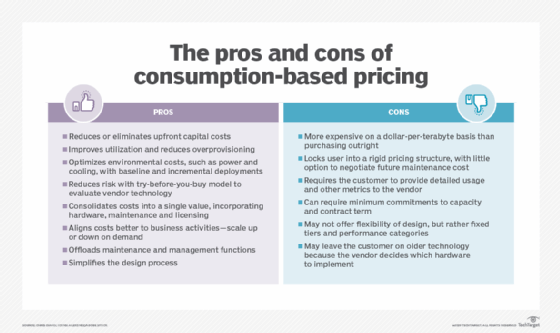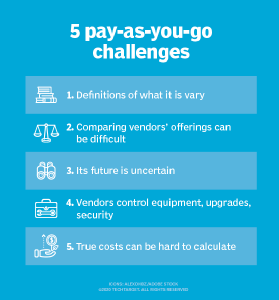Storage
- Editor's LetterSaaS data protection is a challenging but critical task
- Cover StoryExplore the consumption-based IT and Opex storage landscape
- InfographicData storage trends include increases in cloud, NAND flash
- FeatureAWS Outposts vs. Azure Stack vs. Google Anthos hybrid storage
- ColumnFive essential steps to build a cloud-native strategy
- ColumnStorage for edge computing is the next frontier for IoT

Explore the consumption-based IT and Opex storage landscape
The evolving consumption IT, pay-as-you-go infrastructure and storage model is a hot trend. Explore benefits, challenges and five top vendors in the field.
As cloud providers continue to entice organizations with their services, hardware vendors have been looking for ways to keep their customers' operations on premises. This has led companies such as Dell Technologies, HPE and Lenovo to offer consumption-based IT services that aim to bring a cloud-like experience to data centers, edge environments and other on-site locations.
Under these new programs, customers lease the equipment from vendors on a subscription basis, but pay only for the resources they use, moving from a Capex to an Opex model. But the idea of consumption-based IT is still relatively new, and the landscape can be confusing, with little consistency from one vendor to the next. Organizations that try to navigate this terrain can find it difficult to determine what services each vendor offers and how those services compare.
How consumption-based IT changes companies
Consumption-based IT programs make it possible for organizations to get cloud-like services in their data centers and other on-premises locations, with minimal upfront costs. Organizations pay only for the services they use, unlike purchasing the hardware outright, which can result in overprovisioning and the need to support underutilized hardware. With consumption-based IT, customers typically pay a monthly subscription fee based on usage and level of service. Some vendors also offer value-added services such as advanced monitoring or AI-driven insights.
Many consumption-based vendors include reserved capacity with their hardware that sits unused until the customer needs it. In this way, organizations can more easily handle fluctuating workloads without having to invest in hardware they use only part of the time. The vendor continuously monitors usage to ensure accurate billing; customers can also use the collected data to plan capacity and tie budgets to specific workloads.
Most vendors also offer some level of management and support, although these services can vary significantly from one vendor to the next as well as between packages from the same vendor. The vendor will typically provision, deliver and install the systems and provide support. Some consumption-based packages also include ongoing system administration to offer an even greater cloud-like experience.
Consumption-based programs promise to simplify IT and deliver greater flexibility than traditional approaches. If the programs can live up to their promises, they can help companies increase their agility by aligning infrastructure more closely with the dynamic nature of today's workloads. In this way, organizations can be more responsive to changing market conditions and customer requirements. At the same time, IT can focus on higher priority initiatives and more innovative efforts. Taken together, these changes can provide organizations with a competitive edge, but only if they can realize the benefits of consumption-based IT, while minimizing the disadvantages.
Measure the benefits vs. challenges
Organizations have embraced the consumption-based model because it can address the challenges of traditional on-premises systems and public cloud services. Among the benefits are the following:
- Consumption-based IT services adhere primarily to an Opex model with a predictable rate structure, which reduces or eliminates upfront capital costs.
- Metering capabilities provide visibility into resource usage, which makes it easier to budget resource allocation and tie resources to specific workloads.
- Many vendors configure their hardware with reserved capacity or provide easy scale-up capabilities, which results in greater flexibility and reduces the need to predict future workload requirements.
- Although consumption-based programs offer different levels of management services, the programs in general can help simplify IT and make it easier to plan, procure, deploy, maintain, monitor, upgrade and retire infrastructure.
- Customers have more control over their systems and data than they do with cloud services, which can be an important consideration with security and compliance requirements.
- Pay-for-use services can help minimize risks and potentially lead to cost savings by reducing the need to overprovision resources or support unused resources. They also provide the flexibility to scale and refresh hardware as necessary.
But challenges exist. For example, the TCO might be higher than buying the hardware outright, especially since customers have nothing to show for their investments after the leasing period ends. Customers are also required to commit to minimum capacity levels and lengths of service.
At the same time, customers have less control over how infrastructure components are assembled and when equipment and software are refreshed and updated when compared to purchasing the equipment outright. Vendors also collect metrics about usage and other operations and often need access to manage the systems.

Five examples of consumption-based products and services
Consumption-based services for on-premises infrastructure is a young industry. It lacks a widely accepted definition of what these services are and what they should provide. This can make it difficult to compare services between vendors because they each take a unique approach.
Here are offerings from five vendors whose programs rank among the top contenders in the consumption-based IT market. They represent a good cross-section of what decision-makers are up against when trying to make sense of available services.
Dell Technologies Apex
Dell Technologies recently introduced its Apex infrastructure services to gain a more solid foothold in the consumption-based IT market. At some point, Dell plans to deliver its full portfolio as infrastructure services through the Apex program, which provides the following four categories of services:
- Apex Data Storage Services. Dell offers both block and file storage services. Each storage type is available in three tiers, which are differentiated by performance and base capacity requirements. The storage comes with extra buffer capacity that's available on demand. Customers pay only for the capacity they use, with no overage fees. Dell handles delivery, deployment, monitoring, operations and decommissioning.
- Apex Cloud Services. The cloud services are based on Dell EMC VxRail hyperconverged infrastructure (HCI) and VMware software. Dell offers two deployment models: private cloud and hybrid cloud. Customers can deploy the systems on their own racks or on Dell's fully configured racks. If they deploy the hybrid cloud model, customers can also choose between VMware's Cloud Foundation standard or enterprise editions. Pricing is based on a per-instance, per-month fee structure.
- Apex Flex on Demand. This program enables customers to pay for technology as they use it and provides them with immediate access to buffer capacity. Flex on Demand is available for PowerEdge servers; select HCI products; PowerProtect DD and PowerProtect DP data protection appliances; and PowerStore, PowerMax, PowerFlex, PowerScale and Elastic Cloud Storage. Customers pay a fixed cost for their committed capacity plus the variable cost of buffer capacity. They can adjust their committed capacity as workloads change.
- Apex Data Center Utility. Dell combines its product portfolio with a choice of professional services and support, offering a complete package to manage a customer's data center and its operations. Dell uses automated tools to record the actual consumption and then provides that information to the customer for review. The customer then receives a single invoice for all services at a predictable rate that's based on actual usage. Customers can customize the service to meet their specific business requirements.
Dell offers the Apex Console to work with Apex services. The Console provides a self-service portal that customers can use to subscribe to different services, as well as to expand their resources and add new ones. They can also use the portal to monitor the health and performance of Apex resources and configure alerts and notifications.
HPE GreenLake
HPE has been at the forefront of the consumption-based effort with GreenLake, a pay-per-use program that delivers HPE infrastructure as a service to multiple customer locations, including edge, data center and colocation settings. HPE delivers the systems preconfigured and manages them throughout their lifecycles.
HPE has made GreenLake available for a variety of HPE products and plans to offer its entire portfolio by 2022. GreenLake uses advanced metering technology to enable the pay-for-use model, basing it on a wide range of metrics. Although customers must make a minimal resource commitment, they pay only for what they use beyond that.
The real powerhouse behind the GreenLake program is HPE GreenLake Central, a software platform that provides customers with the following capabilities to manage and optimize their GreenLake services:
- Access GreenLake resources. Through a single portal, IT can view key performance indicators, purchase apps and services through the HPE marketplace, and gain quick insights into GreenLake resources to better manage apps and data.
- Analyze consumption. IT can view usage and cost analytics for their entire hybrid estate. GreenLake Central provides aggregated usage data across on-premises and public cloud platforms, as well as rules-based insights that can help optimize systems.
- Plan future capacity. By monitoring usage, admins can compare how much capacity they have used against what's available, which enables them to predict when they'll need more capacity based on historical usage and trends.
- Deploy and manage services. GreenLake Central makes it easy for administrators to provision, monitor and manage GreenLake resources. They can also view statistics about overall CPU, storage and memory utilization, as well as use preconfigured workloads to quickly provision resources.
- Monitor for governance, risk and compliance. GreenLake Central provides more than 1,500 controls to monitor GreenLake systems. The platform enables users to identify compliance failures and risks and produces comprehensive reports to help streamline audits.
HPE offers the GreenLake services as packaged infrastructure. For example, one of the listed packages is Private Cloud, which is based on the HPE Synergy composable infrastructure appliance. The package comes with either VMware Cloud Foundation or Red Hat OpenStack. Another package is Storage, which includes several configurations based on HPE Primera or HPE Nimble Storage systems. HPE also offers packages such as Machine Learning, Database Platform and High Performance Computing.
Lenovo TruScale Infrastructure Services
The TruScale program targets all organizations with infrastructure that can deploy on premises or at the edge. Customers can choose from Lenovo's ThinkSystem and ThinkAgile product portfolio, including ThinkSystem DE Series All-Flash Arrays. Lenovo installs and deploys the hardware, maintains it throughout the service period and then removes it when that period ends. Lenovo also provides each customer with a dedicated customer success manager who handles the service account.
Unlike most consumption-based IT programs, Lenovo requires no minimum capacity commitment. Customers can define their plans with any configuration that meets their requirements, whether they want to emphasize server or storage resources, or need a more specialized configuration, such as hyperconvergence or high-performance computing.
TruScale is strictly a pay-as-you-go program that enables customers to scale up or down as necessary. The program offers easy-to-add incremental capacity and predictable monthly payments based on usage. Customers have continuous, real-time visibility into their consumption, with access to multiple layers of information, helping to control and predict costs and resolve potential problems.
Lenovo has also teamed up with SAP and Nutanix to provide additional TruScale services.
- TruScale with SAP S/4HANA Cloud. Customers get a single pay-as-you-go product based on Lenovo servers and storage that have been certified for SAP HANA. The package also includes an on-premises version of SAP S/4HANA Cloud. The TruScale service is available only through SAP.
- TruScale for Hosted Desktops with Nutanix. This package provides a complete virtual desktop platform that includes Lenovo ThinkAgile HX HCI with Nutanix Cloud software. The package also comes with select Lenovo thin clients or PCs, as well as Citrix Virtual Apps and Desktops or other virtual desktop infrastructure software.
TruScale includes metering that's separate from and outside the customer's data plane. Customers own and control their own security policies at the application layer and above. Lenovo provides a hands-off plugin to facilitate 24/7 remote monitoring and management, which is handled by Lenovo's professional services experts.
NetApp Keystone
Keystone offers a portfolio of services based on NetApp storage products and cloud software. Keystone enables customers to set up hybrid cloud environments that span on premises and the cloud. NetApp offers customers three financing options for acquiring Keystone services:
- Flex Pay provides financing, leasing and fixed or variable payment options to accommodate different cash flow and budgeting needs, which makes it possible for organizations of all sizes to own their own equipment.
- Flex Subscription follows a pay-as-you-go subscription model that offers customers hybrid cloud storage services that reduce upfront costs and support a 100% Opex model.
- Flex Utility is a utility service that provides customers with a single subscription for their on-premises and cloud services, which makes it possible to scale across any cloud.
Of these three options, only Flex Subscription offers customers the type of pay-as-you-go services comparable to those from Dell, HPE and Lenovo. The Flex Subscription plan lets customers choose one of many service levels. The levels define the type of storage -- block, object, or file and block -- and the expected performance. Each service level comes with a minimum capacity requirement.
The Flex Subscription program is available in three operating models that define who's responsible for specific operations:
- NetApp operated. NetApp is responsible for building, monitoring, administering, operating, optimizing and supporting the Keystone system.
- Partner operated. A NetApp partner is responsible for building, monitoring, administering, operating, optimizing and supporting the Keystone system.
- Customer operated. NetApp is responsible for building and supporting the Keystone system. The customer is responsible for monitoring, administering, operating and optimizing the system.
In all three operating models, NetApp owns the hardware and software and controls which software version is used and when it can be upgraded. However, customers that sign up for the NetApp-operated model can also use the NetApp Service Engine, a self-service portal to provision storage, view reports about consumption levels, and initiate service requests or subscription changes. NetApp also offers data protection as an add-on service to the basic packages.
Pure Storage as-a-Service
Pure Storage offers multiple financing options for its storage products, but it's not always clear what the vendor considers to be storage as a service (STaaS), in part because of inconsistencies in the company's own labeling. In some places, Pure Storage includes the following four packages in its STaaS portfolio:
- Evergreen Storage. Pure Storage products are offered on a straightforward subscription basis, but with the added benefit of continuous improvements and component-level upgrades that can span a decade or more.
- Pure as-a-Service. Customers can get STaaS for on premises and public cloud, providing a pay-for-use hybrid cloud experience with one subscription and one set of storage services.
- Portworx. This package enables customers to run any cloud-native data service in any cloud using any Kubernetes platform. It offers data security, data protection, high availability and hybrid cloud mobility.
- Pure Cloud Block Store. The service delivers data mobility and protection for cloud block storage on both AWS and Azure and provides infrastructure efficiency with features such as compression, deduplication and thin provisioning.
In some cases, Pure Storage classifies only Pure as-a-Service and Pure Block Cloud Store as STaaS. However, only Pure as-a-Service is comparable to the programs offered by Dell, HPE and Lenovo.
Pure as-a-Service includes two types of storage: block storage and unified file and object storage. The vendor offers block storage services in four tiers and file and object storage services in two tiers, with each tier providing a different level of performance.
Pure as-a-Service offers a 100% Opex subscription model. Customers pay only for what they use. In addition to the storage itself, a subscription includes the Pure1 management tools, which enable customers to manage their hybrid cloud environments from a single dashboard. They can also use the tools to perform VM analytics and access AI predictive support.
Five questions to ask your vendor
The consumption-based IT services offered by Dell Technologies, HPE, Lenovo, NetApp and Pure Storage make it clear that pay-as-you-go programs can vary significantly from one vendor to the next. To muddy the waters even further, many vendors, such as NetApp and Pure Storage, offer multiple programs, some of which don't fit the consumption-based model.

For this reason, decision-makers must carefully vet each vendor's services to determine which ones qualify as consumption-based. Once they do, they should then ask each vendor five important questions before choosing one over the other.
- What service-level commitments and guarantees are offered as part of the consumption-based package?
- Is there a trial period or some other method to test the products and services before committing to a long-term contract?
- Can the vendor provide precise specifications about the hardware, software and other components and features that are included in a package, and when those components are refreshed and updated?
- What planning, managing, monitoring, metering and troubleshooting services are included with the package?
- What will it take to deploy and integrate the vendor's systems into your environment?
Consumption-based IT programs vary significantly. For this reason, decision-makers should make no assumptions about what a vendor is offering and should try to learn everything they can about a program to ensure they'll get what they expect if they do sign up. The last thing you want is to be unpleasantly surprised after committing to a pay-per-use service.
Dig Deeper on Storage management and analytics
-
![]()
HPE storage battles hard and smart in challenging market
By: Antony Adshead
-
![]()
The 'on-premises as-a-service' genie is out of the bottle
By: Simon Robinson
-
![]()
Artificial intelligence, Nvidia took center stage at HPE Discover 2024
By: Scott Sinclair
-
![]()
HPE to offer KVM virtualization for GreenLake private cloud
By: Tim McCarthy
























